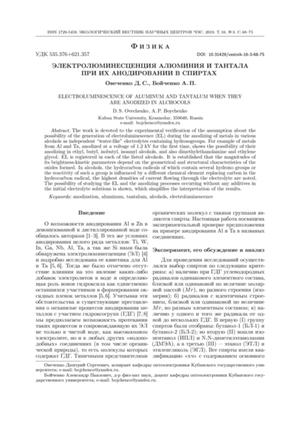Электролюминесценция алюминия и тантала при их анодировании в спиртах
УДК
535.376+621.357EDN
ZNPSNODOI:
10.31429/vestnik-16-3-68-75Аннотация
На примере анодов из Al и Ta при напряжении 1,2~kV показана возможность их анодирования в чистых спиртах и генерация при этом процессе электролюминесценции (ЭЛ), что исключает необходимость учета каких-либо добавок в исходных растворах электролитов и упрощает интерпретацию результатов исследований этого явления. У спиртов, углеводородные радикалы которых содержат несколько гидроксогрупп, или на реакционную способность такой группы оказывает влияние иной химический элемент, замещающий углерод в углеводородном радикале, отмечены наиболее высокие плотности протекающего через электролит тока.
Ключевые слова:
анодирование, алюминий, тантал, спирты, электролюминесценцияБиблиографические ссылки
- Lisenkov A.D., Poznyak S.K., Zheludkevich M.L., Ferreira G.S. Aluminum anodization in deionized water as electrolyte // J. Electrochem. Soc. 2016. Vol. 163. P. 364–368. DOI: 10.1149/2.0881607jes
- Voon C.H., Derman M.N., Hashim U. and ect. Synthesis of nanoporous zinc oxide by anodizing of zinc in distilled water // Appl. Mech. Mater. 2015. Vol. 754–755. Р. 1126–1130. DOI: 10.4028/www.scientific.net/AMM.754-755.1126
- Voon C.H., Lim B.Y., Hashim U. and ect. Effect of temperature of distilled water on the morphology of nanoporous zinc oxide synthesis by anodizing // Appl. Mech. Mater. 2015. Vol. 754–755. Р. 1131–1135. DOI: 10.4028/www.scientific.net/AMM.754-755.1131
- Овеченко Д.С., Бойченко А.П. Электрохемилюминесценция металлических анодов в дистиллированной воде // VIII Международная конференция по фотонике и информационной оптике: Сб. научных трудов. М.: НИЯУ МИФИ, 2019. С. 407–408. [Ovechenko, D.S., Boychenko, A.P. Elektrohemilyuminescenciya metallicheskih anodov v distillirovannoj vode [Electrochemiluminescence of metallic anodes in distilled water]. In: Mezhdunarodnaya konferenciya po fotonike i informacionnoj optike: Sb. nauchnyh trudov. NIYAU MIFI [Proc. of VIII International Conference on Photonics and Information Optics], Moscow, 2019, pp. 407–408. (In Russian)]
- Овеченко Д.С., Бойченко А.П. Свечение металлов при их анодировании в дистиллированной воде // Письма в ЖТФ. 2019. Т. 45. Вып. 10. С. 31–33. DOI: 10.21883/PJTF.2019.10.47753.17723 [Ovechenko, D.S., Boychenko, A.P. Svechenie metallov pri ih anodirovanii v distillirovannoj vode [Glow metals when they are anodized in distilled water]. Pis'ma v ZHTF [Tech. Phys. Let.], 2019, vol. 45, iss. 10, pp. 31–33. (In Russian)]
- Овеченко Д.С., Бойченко А.П. Электролюминесценция металлов при их анодировании в деионизованной воде // Научный альманах. 2019. № 10-2(48). С. 75–80. DOI: 10.17117/na.2019.02.02.075 [Ovechenko, D.S., Boychenko, A.P. Elektrolyuminescenciya metallov pri ih anodirovanii v deionizovannoj vode [Electroluminescence of metals when they are anodized in deionized water]. Nauchnyj al'manah [Science Almanac], 2019, no 10-2(48), pp. 75–80. DOI: 10.17117/na.2019.02.02.075 (In Russian)]
- Stojadinović S., Vasilić R., Kasalica B., etc. Luminescence During the Electrochemical Oxidation of Aluminum. In: Electrodeposition and Surface Finishing. Ser. Modern Aspects of Electrochemistry. Vol. 57. N.Y. Springer-Verlag, 2014. P. 241–302. DOI: 10.1007/978-1-4939-0289-7_5
- Батаронов И.Л., Гусев А.Л., Литвинов Ю.В. и др. О механизме анодного окисления алюминия в водных растворах электролитов // Альтернативная энергетика и экология. 2007. № 11(55). С. 118–126. [Bataronov, I.L., Gusev, A.L., Litvinov, Yu.V. O mekhanizme anodnogo okisleniya alyuminiya v vodnyh rastvorah elektrolitov [On the mechanism of anodic oxidation of aluminum in aqueous electrolyte solutions]. Al'ternativnaya energetika i ekologiya [Alternative Energy and Ecology], 2007, no. 11(55), pp. 118–126. (In Russian)]
- Заболоцкий В.И., Никоненко В.В. Перенос ионов в мембранах. М.: Наука, 1996. 392 с. [Zabolockij, V.I., Nikonenko, V.V. Perenos ionov v membranah [Ion transport in membranes]. Nauka, Moscow, 1996. (In Russian)]
- Zaraska L., Sulka G., Jaskuł A.M. The effect of n-alcohols on porous anodic alumina formed by self-organized two-step anodizing of aluminum in phosphoric acid // Surface and coatings technology. 2010. Vol. 204. P. 1729–1737. DOI: 10.1016/j.surfcoat.2009.10.051
- Alsamuraee A., Mohammed Doss Al-Ittabi Q., Mohammed Y. Electrochemical formation of Titania Nanotubes in non-aqueous electrolyte // Am. J. Sci. Ind. Res. 2011. Iss. 2(6). P. 852–859. DOI: 10.5251/ajsir.2011.2.6.852.859
Скачивания

Даты
Поступила в редакцию
Принята к публикации
Публикация
Как цитировать
Лицензия
Copyright (c) 2019 Овеченко Д.С., Бойченко А.П.

Это произведение доступно по лицензии Creative Commons «Attribution» («Атрибуция») 4.0 Всемирная.


